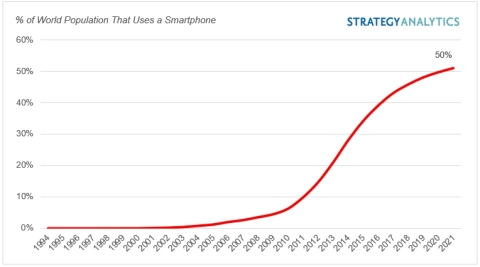Smartphones are everywhere. It’s pretty rare to come across someone who doesn’t have a smartphone, and a new report sheds light on just how rare that actually is.
According to a new report from Strategy Analytics, roughly four billion people in the world are currently using a smartphone. In other words, half the human population has a smartphone. This also makes the smartphone the most successful computer in history, leaving personal computers, laptops, and tablets far behind.
Half of humanity now owns a smartphone. The smartphone is the most successful computer of all time. Smartphones today are used by 4 billion people worldwide, from urban California to suburban China and rural Africa. Consumers and workers love the convenience, utility, and safety of having a connected computer in their pocket. Smartphones have become an essential daily tool. We predict 5 billion people will be using smartphones worldwide by 2030.
Exhibit 1: Global Smartphone User Base: % of World Population (1) (Source: Strategy Analytics, Inc.)
It took 27 years to reach this milestone. The smartphone user base hit the 1 billion mark in 2012, and as of June 2021, there are 3.90 billion users worldwide if this report is accurate.
It all started with the IBM Simon, the first-ever device to be categorized as a smartphone. The IBM Simon launched all the way back in 1994. It featured a black and white 4.5-inch x 1.4-inch LCD with 293 x 160 screen resolution and touch and stylus support. It had a Vadem 16-bit x86-compatible CPU that ran at a clock speed of 16Hz along with 1MB ROM and 1MB of RAM. And at $900, it was expensive, too — right there with some of the recent flagships.
Of course, we can't forget about the first-generation iPhone from Apple. That product can be credited for making smartphones mainstream, and its success led many companies to design and build their own competing smartphones.
Fast forward to 2021, and we can clearly see how far we have come. Today, we have smartphones that pack up to 18GB of RAM and 512GB of storage, feature high-resolution multi-setup cameras with unbelievable zoom capabilities, and have truly breathtaking displays. The contrast between the IBM Simon and a modern smartphone couldn’t be starker.
How many years will it take to reach the next 4 billion users?
Featured image by Daniel Romero on Unsplash


